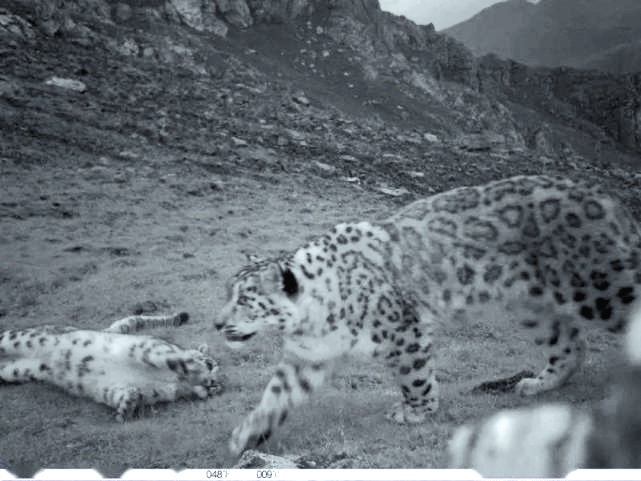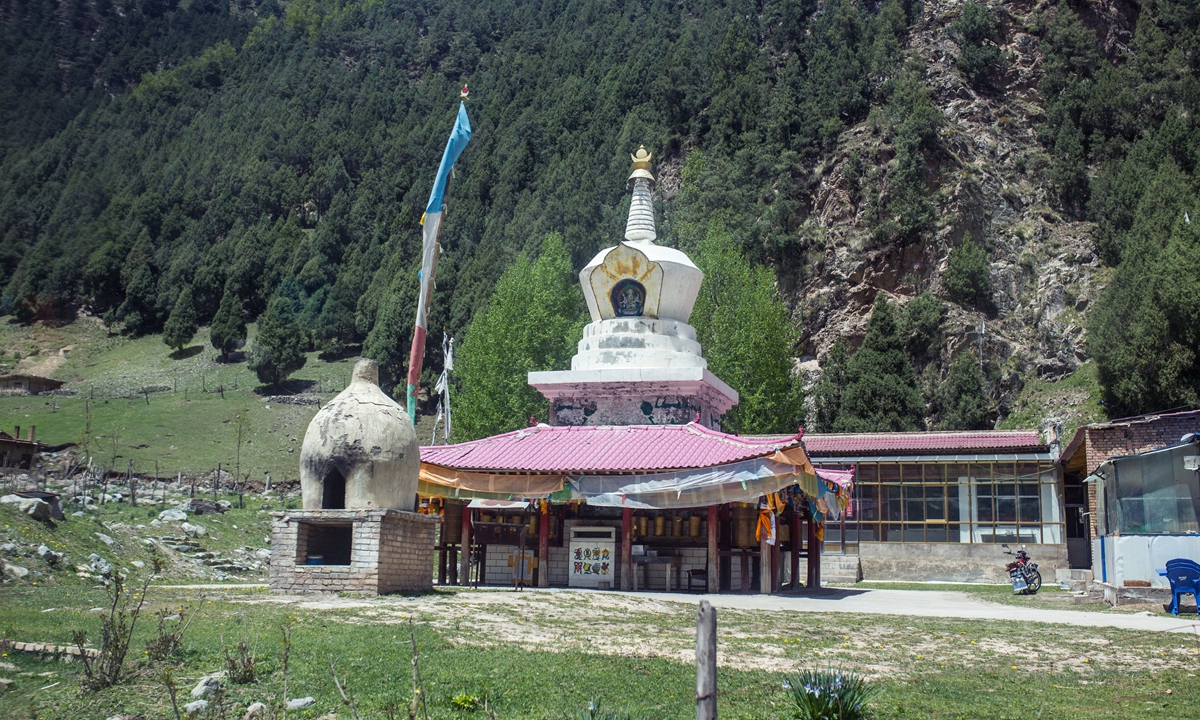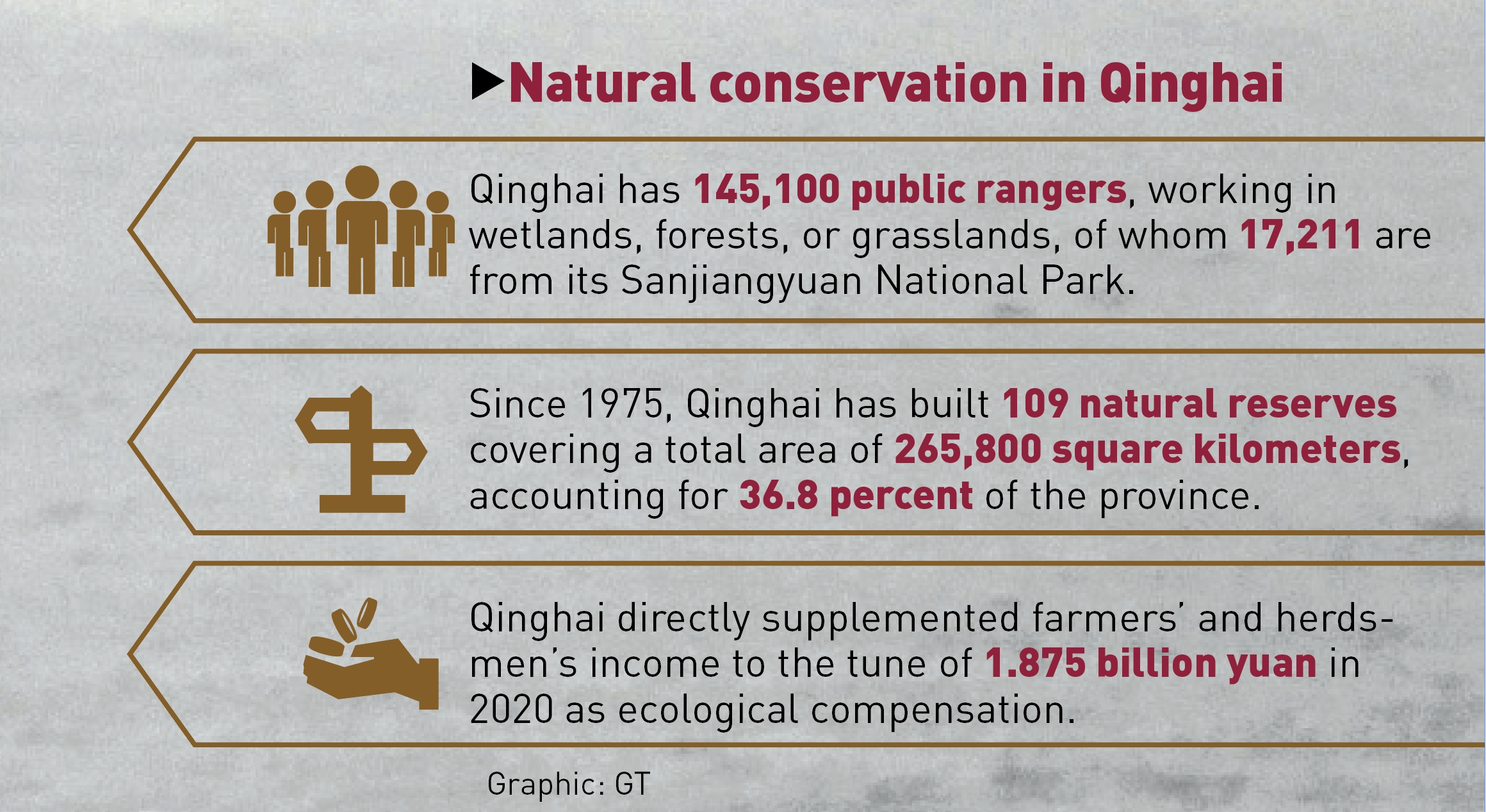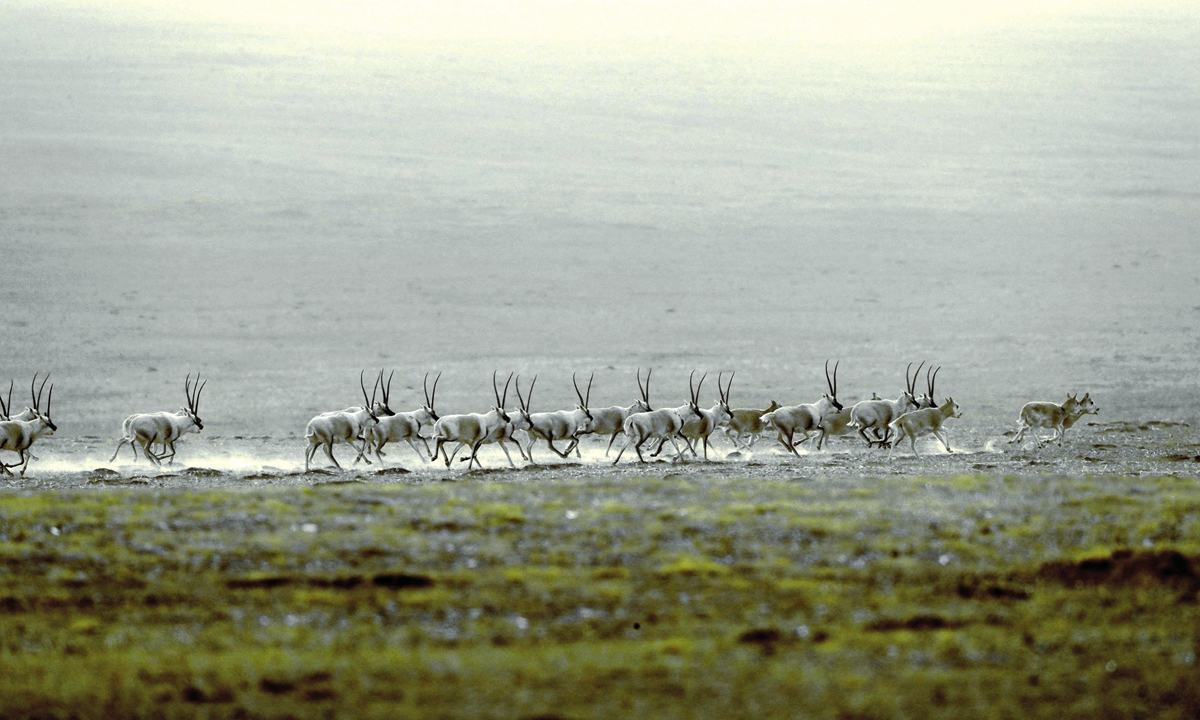Since two snow leopards – a mother and her cub – were captured by an infrared camera in the mountains on the night of September 30, 2020, the Beishan Forest Farm has repeatedly found traces of the big cats, whether footprints or attacks on livestock.
Locals say this proves the efforts in conserving the ecological environment in the past two decades has been a success.
The leopards’ casual tussle excited scientists extremely. It was the first time that snow leopards had been captured on the eastern end of the Qilian Mountains by camera in the farm of Northwest China’s Qinghai Province.

Snow leopards captured by an infrared camera in Qilian Mountains in September 2020.
“Some local residents over 60 years old said they heard there were snow leopards here, but nobody had ever seen them,” Zhao Changhong, director of Beishan Forest Farm, said.
As the Qinghai-Tibet Plateau ecosystem’s flagship species, snow leopards’ existence could dictate how healthy the local ecosystem is.
People say that ecological conservation stories in Qinghai Province on the Qinghai-Tibet Plateau are the epitome of China’s progress on this issue. After decades of rapid development, the tide on the cost of economic progress and development is turning. In Qinghai’s case, the ecology has been identified as being of the “biggest value, duty, and potential.” Under the need for environmental protection, some regions in the province have had to forfeit some profits in developing industries and tourism.
Qinghai has engineered a public ranger system, with 145,100 people joining, working in wetlands, forests, or grasslands, of which 17,211 are from its Sanjiangyuan National Park, the origins of the Yangtze River, the Yellow River, and the Lancang (Mekong) River.
Priority will be given to selecting people from families with difficulties in life such as ecological immigrants, so as to help rid them of poverty through stable remuneration. Qinghai directly supplemented farmers’ and herdsmen’s income to the tune of 1.875 billion yuan ($293 million) in 2020 as ecological compensation.
Stealthy recovery
In July 2020, after around two decades of halting logging, the Beishan Forest Farm of Huzhu county and Northwest Institute of Plateau Biology under the Chinese Academy of Sciences set up 24 infrared cameras for investigating wildlife after finding traces of the big cats in forests.
The leopards ate four or five sheep of the herdsmen. “But the residents are fine with it. Local Tibetans believe it means good fortune,” Zhao said. “Snow leopards had not been seen here for decades.”
In recent years, more snow leopards have been spotted in the wider region, thanks to the protection of the ecology in the past couple of years, together with increased monitoring means, Qi Xinzhang, vice director at the Xining Wildlife Park and Qinghai wildlife rescue and breed center, told the Global Times.

Shuimo and Youhua, snow leopard twins at Xining Wildlife Zoo Photo: Shan Jie/GT
In March this year, Qi and his team rescued a snow leopard at a village in Menyuan county located also on the east side of the Qilian Mountains.
The big cat hit and broke glass, and was believed to have gotten a concussion – it was too dizzy to react to approaching humans. “I’m 51. I had heard of the snow leopard as a protected animal, but had never seen one before,” Ma Shengcai, the first witness, said.
After a thorough check and several days of rest at Qi’s rescue center, the leopard was released into the wild.
“We put a GPS tracker on it, and so far found it patrolling a huge territory, covering different counties,” Qi said, “Snow leopards are at the top of the food chain, suggesting the ecosystem in the whole area is healthy.”

Dabao, a snow leopard rescued by the Qinghai wildlife rescue and breed center Photo: Shan Jie/GT
Qinghai has a unique but fragile ecological system with species from the high plateau, such as the Tibetan antelope, Przewalski’s gazelle, and the snow leopard.
To maintain such biodiversity takes great effort, and might, unfortunately, have a human cost. One of the most told stories was the sacrifice of Sonam Dhargey, an official in Yushu Tibetan Autonomous Prefecture of Qinghai who was fatally wounded in a gunfight with Tibetan antelope poachers in 1994 in Hoh Xil.
With tough protection measures, the population of Tibetan antelopes has risen to 300,000. Nowadays, the environmental monitoring center in Xining has access to real-time footage of the antelopes and other wildlife with the help of 46 monitoring spots in the province.
From woodcutters to forest guards
Beishan Forest Farm, with an area of 1,127 square kilometers, has a unique but “reasonable” ecosystem of a mixed broadleaf-conifer forest. At least 1,209 plant and 198 animal species live here, winning the region the title of “the green kingdom.” River Langshidang, meaning “water mill” in Tibetan, flows through the forests.
Although it is only 55 kilometers from Xining, capital of Qinghai, it is still a three-hour-long journey traversing mountainous terrain and cutting through tunnels.
The farm has 610 forest guards, or officially the “public rangers.” Liu Zhilong is one of them.
Liu, now wearing an armband with the words “forest fire prevention” emblazoned on it, used to be a lumberjack in these forests 25 years ago.
He could fell up to 20 trees a day.

Liu Zhilong, a forest guard at the Beishan Forest Farm, looks up, checking for signs of pests on the trunks and leaves of a tree. Photo: Shan Jie/GT
“The state-owned farm could make a profit of more than 3 million yuan a year in the 1980s. Pretty sizable at that time,” Zhao said.
People were enthusiastic about cutting trees at that time. In the 1990s, the forests had been damaged severely. “We cut 30-year-old trees, but the forest needs 80 to 100 years to recover,” Zhao said.
After the massive 1998 flood disaster of the Yangtze River, China initiated a national natural forest protection project. Logging was called to a halt in Beishan.
The running of the forest farm began to rely on financial allocation from the government, and lumberjacks like Liu had to look for other sources of livelihood, until in the recent decade, more than 100 of them were reemployed by the farm to become forest guards, earning about 2,500 yuan a month.
“I saw the flood and the sandstorms on TV. I understand how important it is to protect our forest reserves,” he said.
Cutting the income of logging does not mean a dip in life quality, and working and living in the mountains does not necessarily have to be enclosed and boring.
“There is cell phone service everywhere in the mountain now,” Dong Dorje, Liu’s colleague and a villager of Zhalonggou, told the Global Times. “Using a phone could keep us safe. Also, we can watch some videos while garrisoned on mountains.”

A Tibetan Buddhist temple inside the Beishan Forest Farm, where the local residents are mostly Tibetans Photo: Shan Jie/GT
Not surprisingly, Zhalonggou, where the forest guard station is located, has a tradition of valuing education, and more than 17 provincial-level senior officials and a dozen living Buddhas were from this village. One of Dong’s brothers is a university chancellor.
With a stable income, some of the forest guards who had previously lived in poverty in Beishan have been lifted from it.
Despite the signal towers, infrastructure construction has not stopped in the region.
The building of an expressway passing through the forests is ongoing, which has spent one third of its finance on environmental protection. Local authorities are also closely monitoring the project to avoid it causing any damage to nature.
China has fully banned commercial logging of natural forests since 2017. What is happening in Beishan is also happening around the country, with millions of loggers becoming forest guards, enlisted in tree-planting efforts and forest fire prevention.

GT
The road less traveled – China’s exploration of national park system sees progress
Meanwhile, the country has been seeking new avenues in ecological conservation, and building a national park system is considered a key solution.
China should promote and accelerate building a natural reserve system with national parks as the main body, and completing a related supervision system, to reinforce the national ecological safety shield, Chinese Minister of Ecology and Environment Huang Runqiu said at the national World Environment Day event on Saturday in Xining.
China’s foray into the current national park system was first piloted in Qinghai in 2015, drawing international attention, as well as sparking doubts.
“Can China marry the goals of conservation and tourism, while safeguarding the livelihoods and culture of the approximately 128,000 people who live within or near the park’s boundaries, many of them Tibetan?” questioned an AP story after the plan was announced.
Xin Changxing, governor of Qinghai, said on Saturday that Qinghai has been completing plans for the Sanjiangyuan National Park and the Qilian Mountain National Park and is at the early stages of planning for another two in Qinghai Lake and the Kunlun Mountains.
A day after, China’s forestry authority further bolstered the national park system by confirming the official set of the first batch of national parks in the country.
But the region is still facing challenges and is seeking out relative solutions.

Tibetan antelopes in Northwest China’s Qinghai Province Photo: Courtesy of Ge Yuxiu
One particular problem is the settlement of residents inside the natural reserves. Since 2005, more than 50,000 Tibetan herdsmen have abandoned the nomadic life in order to preserve the fragile ecosystem. Many of them have been relocated to towns.
The herdsmen and farmers in natural reserves received subsidies, and many of them became public rangers, getting a stable income. Each senior resident above 55 years in the Sanjiangyuan region is included in the medical insurance. Schools in natural reserves have their special textbooks about ecologic protection.
The other problem is on administration.
Since 1975, Qinghai has built 109 natural reserves covering a total area of 265,800 square kilometers, accounting for 36.8 percent of the province.
“The reserve region is wide-set, and the conflicts [between human activities and nature protection] still exist,” Ren Yong, a senior official at the Qinghai environment department, told the Global Times. One of the reserve areas is as large as two provinces in eastern China. There are still residents, and you cannot tell me to not provide electricity or build roads in it.”
Natural reserves are divided into core, buffer, and experimental regions, with each having strict limits at different levels. For instance, in core regions, human activities are absolutely forbidden. Sometimes the division confuses people.
Ren implied that the province is simplifying the zoning in the natural reserves to solve this problem.
“But above all, the total area of natural reserves is increasing,” Ren said.
Snow leopards captured by an infrared camera in Qilian Mountains in September 2020.




